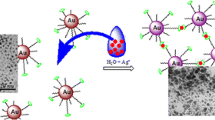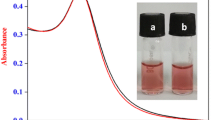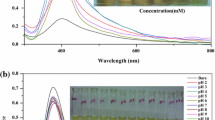Abstract
We describe a colorimetric method for the determination of Hg(II) that is based on the aggregation of silver nanoparticles (AgNPs) in the presence of Hg(II) and lysine. If Hg(II) ions are added to unmodified AgNPs, they will deposit on the surface where they will be reduced to Hg(0) by NaBH4 to form a shell around the AgNPs. Upon addition of lysine to the Hg(II)-capped AgNPs, the aggregation of the AgNPs will be induced because the two amino groups of lysine have a high affinity for Hg(II). Aggregation results in a color change from orange to yellowish. The effect was exploited to design a colorimetric assay for Hg(II) that has a 1 nM detection limit.

A simple, fast, and sensitive, colorimetric probe for the detection of Hg2+ is designed.





Similar content being viewed by others
References
Wood CM, McDonald MD, Walker P, Grosell M, Barimo JF, Playle RC, Walsh PJ (2004) Bioavailability of silver and its relationship to ionoregulation and silver speciation across a range of salinities in the gulf toadfish (Opsanus beta). Aquat Toxicol 70:137–157
Boening DW (2000) Ecological effects, transport, and fate of mercury: a general review. Chemosphere 40:1335–1351
Harada M (1995) Minamata disease: methylmercury poisoning in Japan caused by environmental pollution. Crit Rev Toxicol 25:1–24
Akagi H, Grandjean P, Takizawa Y, Weihe P (1998) Methylmercury dose estimation from umbilical cord concentrations in patients with Minamata disease. Environ Res 77:98–103
Eto K, Tokunaga H, Nagashima K, Takeuchi T (2002) An autopsy case of minamata disease (methylmercury poisoning) pathological viewpoints of peripheral nerves. Toxicol Pathol 30:714–722
Leopold K, Foulkes M, Worsfold P (2010) Methods for the determination and speciation of mercury in natural waters-a review. Anal Chim Acta 663:127–138
Segadea SR, Tyson JF (2007) Determination of methylmercury and inorganic mercury in water samples by slurry sampling cold vapor atomic absorption spectrometry in a flow injection system after preconcentration on silica C18 modified. Talanta 71:1696–1702
Leermakers M, Baeyens W, Quevauviller P, Horvat M (2005) Mercury in environmental samples: speciation, artifacts, and validation. TrAC Trends Anal Chem 24:383–393
Leopold K, Foulkes M, Worsfold PJ (2005) Preconcentration techniques for the determination of mercury species in natural waters. TrAC Trends Anal Chem 28:426–435
Huang CC, Chang HT (2007) Parameters for selective colorimetric sensing of mercury (II) in aqueous solutions using mercaptopropionic acid-modified gold nanoparticles. Chem Commun 1215–1217
Huang CC, Yang Z, Lee KH, Chang HT (2007) Synthesis of highly fluorescent gold nanoparticles for sensing mercury (II). Angew Chem Int Ed 46:6824–6828
Lin CY, Yu CJ, Lin YH, Tseng WL (2010) Colorimetric sensing of silver (I) and mercury (II) ions based on an assembly of tween 20-stabilized gold nanoparticles. Anal Chem 82:6830–6837
Tanaka Y, Oda S, Yamaguchi H, Kondo Y, Kojima C, Ono A (2006) 15N-15N J-coupling across HgII: Direct observation of HgII-mediated T-T base pairs in a DNA duplex. J Am Chem Soc 129:244–245
Xue X, Wang F, Liu X (2008) One-step, room temperature, colorimetric detection of mercury (Hg2+) using DNA/nanoparticle conjugates. J Am Chem Soc 130:3244–3245
Lee JS, Lytton-Jean AKR, Hurst SJ, Mirkin CA (2007) Silver nanoparticle oligonucleotide conjugates based on DNA with triple cyclic disulfide moieties. Nano Lett 7:2112–2115
Hamaguchi K, Kawasaki H, Arakawa R (2010) Photochemical synthesis of glycine-stabilized gold nanoparticles and its heavy-metal-induced aggregation behavior. Colloids Surf A 367:167–173
Zhu J, Yang J, Deng BJ (2009) Enhanced mercury ion adsorption by amine-modified activated carbon. Hazard Mater 166:866–872
Lee JS, Han MS, Mirkin CA (2007) Colorimetric detection of mercuric ion (Hg2+) in aqueous media using DNA-functionalized gold nanoparticles. Angew Chem Int Ed 46:4093–4096
Deng L, Zhou ZX, Li J, Li T, Dong SJ (2011) Fluorescent silver nanoclusters in hybridized DNA duplexes for the turn-on detection of Hg2+ ions. Chem Commun 47:11065–11067
Wang H, Wang YX, Jin JY, Yang RH (2008) Gold nanoparticle-based colorimetric and “turn-on” fluorescent probe for mercury (II) ions in aqueous solution. Anal Chem 80:9021–9028
Zhang RZ, Chen W (2014) Nitrogen-doped carbon quantum dots: facile synthesis and application as a “turn-off” fluorescent probe for detection of Hg2+ ions. Biosens Bioelectron 55:83–90
Zhang LB, Tao L, Li BL, Jing L, Wang EK (2010) Carbon nanotube-DNA hybrid fluorescent sensor for sensitive and selective detection of mercury (II) ion. Chem Commun 46:1476–1478
Freeman P, Finder T, Willner I (2009) Multiplexed analysis of Hg2+ and Ag+ ions by nucleic acid functionalized CdSe/ZnS quantum dots and their use for logic gate operations. Angew Chem Int Ed 48:7818–7821
Ma J, Chen YH, Hou Z, Jiang W, Wang L (2013) Selective and sensitive mercuric (ii) ion detection based on quantum dots and nicking endonuclease assisted signal amplification. Biosens Bioelectron 43:84–87
Acknowledgments
All authors gratefully acknowledge the financial support of key scientific and technological project of Henan Province (122102210406)
Author information
Authors and Affiliations
Corresponding author
Electronic supplementary material
Below is the link to the electronic supplementary material.
ESM 1
(DOC 137 kb)
Rights and permissions
About this article
Cite this article
Li, L., Gui, L. & Li, W. A colorimetric silver nanoparticle-based assay for Hg(II) using lysine as a particle-linking reagent. Microchim Acta 182, 1977–1981 (2015). https://doi.org/10.1007/s00604-015-1536-2
Received:
Accepted:
Published:
Issue Date:
DOI: https://doi.org/10.1007/s00604-015-1536-2




